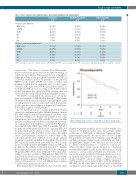Page 167 - 2021_04-Haematologica-web
P. 167
KCyd in high-risk NDMM
Table 2. Best response after induction phase and overall (induction and maintenance).
Response after induction ORR, n (%)
sCR/CR
VGPR
PR SD NA
Response, induction and maintenance
ORR, n (%) sCR/CR VGPR
PR
SD
NA
All patients n=94
83 (88%) 19 (20%) 42 (45%) 22 (23%) 6 (6%)
5 (5%)
85 (90%) 22 (23%) 42 (45%) 21 (22%) 4 (4%)
5 (5%)
Standard-risk patients n=57
49 (86%) 11 (19%) 25 (44%) 13 (23%) 4 (7%)
4 (7%)
50 (88%) 13 (23%) 25 (44%) 12 (21%) 3 (5%)
4 (7%)
High-risk patients n=37
34 (92%) 8 (22%) 17 (46%) 9 (24%) 2 (5%) 1 (3%)
35 (95%) 9 (24%) 17 (46%) 9 (24%) 1 (3%) 1 (3%)
ORR: overall response rate; CR: complete response; sCR: stringent CR;VGPR: very good partial response; PR: partial response; SD: stable disease; NA: not available; n: number.
Figure 2. Median progression-free survival (PFS) according to del17p status.
respectively).24 The efficacy of newer PI in HiR patients may be even more pronounced in the upfront setting, in which the probability of HiR patients treated with KRd of achieving at least a very good partial response (≥VGPR) or a CR was similar to that of SR patients.25 In the phase II FORTE study, similar ≥VGPR rates (79% vs. 86%) and minimal residual disease negativity (62% vs. 49%) were obtained with eight cycles of KRd irrespective of ASCT in both SR and HiR disease according to the R-ISS.26 These results confirmed the efficacy in HiR patients that we observed with carfilzomib in the non-transplant setting.
The IMWG recommends the inclusion of a PI in the upfront treatment of HiR NDMM patients.21 Our results are in line with the evidence that PI, especially those of the second generation such as carfilzomib, can at least partial- ly abrogate the adverse impact of high-risk CA and ame- liorate the prognosis of HiR patients.
As we mentioned above, current approved treatment options in transplant-ineligible NDMM patients include Rd, VMP with or without daratumumab and VRD, with Dara-Rd coming soon. Despite the pitfalls of cross-trial comparisons, the median PFS and OS observed in HiR patients receiving carfilzomib-based therapy in our analy- sis compare favorably with those observed in HiR patients receiving Rd in the FIRST trial15 (PFS: 8.4 months; OS: 29.3 months) and VMP in the VISTA study12 (median PFS: 19.8 months), with results similar to those observed in HiR patients treated with Dara-Rd in the phase III MAIA study.27 Daratumumab, combined to either VMP or Rd, will represent the new standard of care in the upfront treatment of patients ineligible for transplant. The median PFS of patients treated with Dara-VMP was 36.4 months in the recently updated ALCYONE study and NR at 30 months in the MAIA study with Dara-Rd.28,29 Despite these impressive results, the PFS benefit seemed striking in SR patients (HR 0.39 for Dara-VMP and 0.49 for Dara-Rd), while it was less evident in HiR patients (HR 0.78 for Dara-VMP and 0.85 for Dara-Rd). In the era of anti-CD38- based first-line regimens, HiR genetic lesions are still an unfavorable prognostic factor and HiR patients continue to represent an unmet medical need.
Our analysis has some limitations. First of all, the small
number of patients analyzed does not allow definite con- clusions to be drawn on this issue, but prompts further evaluation of carfilzomib as induction therapy in trans- plant-ineligible patients. We used a 10% cut-off to define the positivity or negativity for del17p, even though the median percentage of plasma cells with del17p was slight- ly higher (34%; range: 17-80). The exact cut-off to be used to define del17p positivity is a matter of controversy. While the Mayo Clinic group showed no correlation between PFS and OS and the mutational burden in del17p patients, a recent study published by Thakurta et al. showed a positive correlation between a high cancer clon- al fraction and survival outcomes.30,31 Remarkably, our results remained consistent when a higher cut-off for del17p positivity was adopted (>20%, as in the ENDEAV- OR trial). At the same time as the two trials included in our analysis were being designed, the impact of other HiR
haematologica | 2021; 106(4)
1083


